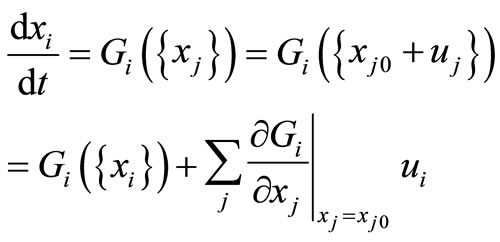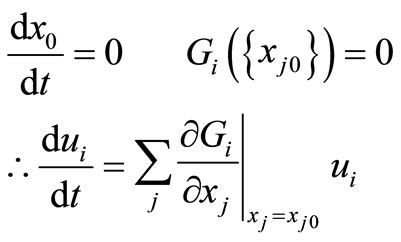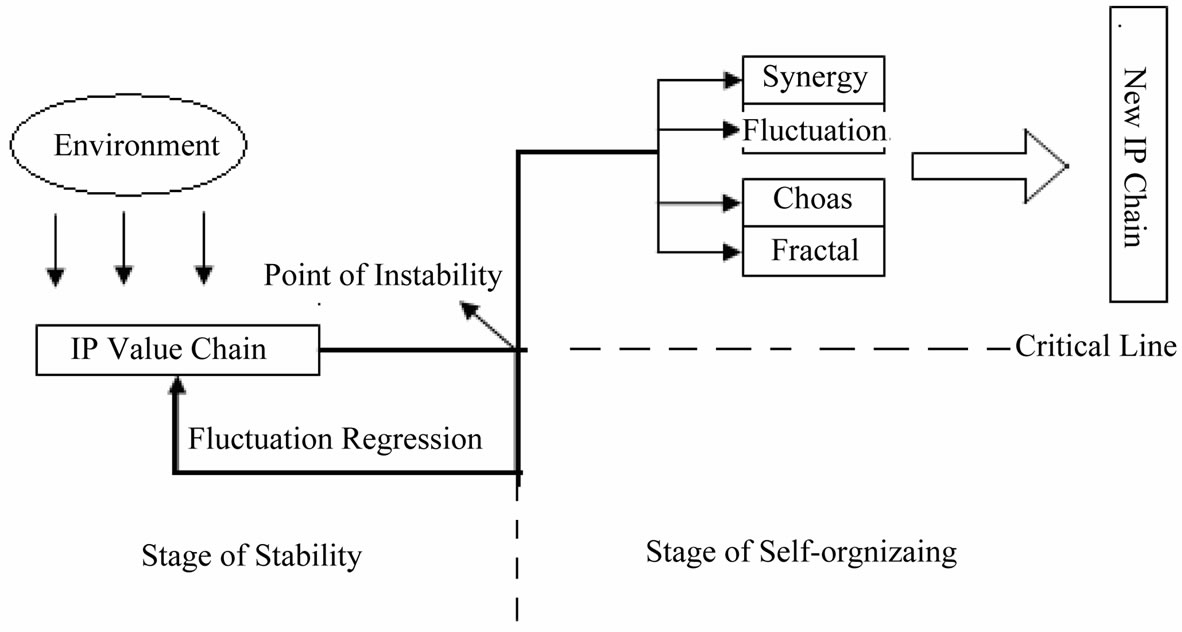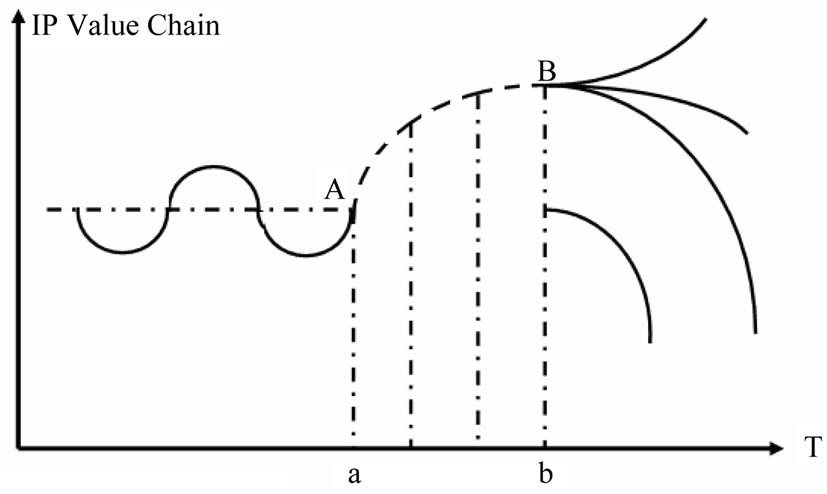American Journal of Operations Research
Vol.2 No.2(2012), Article ID:19950,5 pages DOI:10.4236/ajor.2012.22028
A Study on Mechanism of the Growth and Evolution of Intellectual Property Value Chain: A Self-Organization Perspective
School of Public Affairs, University of Science and Technology of China, Hefei, China
Email: zhangxhe@mail.ustc.edu.cn
Received March 20, 2012; revised April 21, 2012; accepted May 6, 2012
Keywords: IP Value Chain; Growth; Evolution; Self-Organization
ABSTRACT
In the rapid development of technology and knowledge-based economy against the background of the times, the IPR of enterprises participating in the process of value creation has been the key issues in the business world. The resulting growth in the value chain of IP is a complicated process of evolution, and non-linear dynamics, and self-organizing system. This paper explores the intellectual property value chain from its conditions, mechanisms and dynamics as well as the inspiration for the enterprises.
1. Introduction
Since the Harvard Business School’s Michael Porter raised the value chain, which has been widely used in the management practice and made great gains [1]. Porter believes the activities of the enterprises are made of the design, production, sales and various auxiliary ones which are value activities. Based on coordination and management, these activities are able to generate economic benefits and corporate competitive advantage [2]. But with the rapid development of modern science and technology and advent of knowledge-based economy era, the reliance on natural resources and human resources investment as the mainstay of the traditional value chain can not adapt to technology-based management and value creation process. Innovation and independent intellectual property rights have become a modern enterprise’s core competitiveness [3]. In the modern business game competition rules, intellectual property rights have never been so important, therefore, China Premier Wen Jiabao once said: “IPR will be the focus between the international competitions in the future [4].”
From the perspective of intellectual property rights to research the value chain is to combine a series of activities of enterprises and intellectual property, from which, through the conscious integration, we can form IP value chain [5]. In this paper, the business activities are broken down into four parts, respectively strategies, research, R & D, production and marketing. And the IP value chain drawn by the marketing is taken as the main line in the enterprise’s value creation. In the various activities of the value creation process, intellectual property is taken as the key factors to integrate the management and innovation, so enterprises can realize the value creation and growth in its various activities. Through a large number of case studies of successful enterprises, we conclude that the IP value chain management can bring huge gains.
For example, Microsoft, IBM, Google, Samsung, Toyota, as well as China enterprise Huawei, ZTE, and so on are all taking IP as their lifeline in the value creation. Through the activities of the entire enterprise intellectual property management, they upgrade their IP value chain, so they can obtain rapid development or maintain the leadership in their region. Figure 1 is the intellectual property value chain model:
It is easy to see through the chart that the value chain is towed by market. Through the integration and mutual transformation of the both inner and outer IP value chain, we can make the strategy and then coordinate research and development, production and marketing activities, So that intellectual property are able to fully penetrate into the enterprise value creation activities. The value creation depends on the creation, use, management and protection of IP to achieve the upgrade, growth and value-added benefits.
Apparently, the IP value chain is a complicated and nonlinear system. With the exchange of Material, information from the outer environment and the cooperation, competition within the inner chain, the system can achieve the continuous upgrade and competitiveness.

Figure 1. IP value chain model.
2. Mechanism of Growth and Evolution of IP Value Chain under the Dynamic of Self-Organizing System
At present, the academic research of intellectual property management focused on the static external factors such as the legal, policy as well as the management and protection, but put very little attention to the problem of that the intellectual property rights of enterprises participate in the value of self-creation and growth [6]. In the face of such a complex giant system, we are not able to only through regulation and control of external factors contribute to the growth of its evolution, so we must look into the internal self-organization, self-catalysis of the causes of the system dynamic.
The evolution of any system in nature can be summed up in two forms. One is interference by outside forces to promote the evolution of its organization. For example when a computer makes progress, the main strength is man-made cause. The other evolution pattern is of selforganized manner. Haken defined the “self-organization” as: “If a system was in a process of acquiring the spatial, timely or functional structure, there is no outside interference in specific, we say the system is self-organization. Here “Specific” refers to the kind of structure or function of the outside world is not imposed on the system, and the outside world is non-specific way in the role of the system” [7]. For instance, the growth of plants is a selforganized growth mode. Impact of external factors such as water and air can not directly determine the plant’s growth, but non-specific way on the role of this process. The evolution of IP value chain is a nonlinear complex giant system which clearly can not be regulated and controlled by man-made design. Its evolution is a self-organizing process, so the role of external factors is only boundary conditions.
2.1. The Self-Organizing Conditions of IP Value Chain
According to the basic principles of self-organization, intellectual property value chain as a complex system can self-organize includes [8]:
1) Non-linear. If the system is a linear system, it would be a fundamental rule out the possibility of independent evolution, which is also out of the question since the evolution of growth. The non-linear system is that the elements of the system in terms of quantity or nature have a lot of difference and independence. Intellectual property value chain system cover all elements of the above characteristics such as patents, trademarks, trade secrets, production, R & D and marketing activities, as well as technology, capital, personnel, facilities, information and so on.
2) Open system. If IP value chain want to build a system from the disorder to the orderly evolution of the structure, with the outside world must continue to have the material, energy and information exchange. From the chart1 of the property value chain model, we can clearly see the exchanges both in the external links with the outside world of information, materials and energy and the external market through the export of products, technology and so on.
3) System away from equilibrium conditions. The various components of the system must have differences which are opposite to the Uniform and single. The four parts of IP value chain have clear differences and independence, so it can be far away from equilibrium conditions.
4) Input to a certain threshold. Only with a certain threshold, can IP value chain enter into the instability so that it starts the self-organizing evolution. The inputs for the growth of IP value chain from the outside is talent, capital, management, as well as intellectual property rights and so on.
5) Fluctuation. Fluctuation is the flip-flop of IP value chain and unpredictable. Chaos Theory shows that the non-linear system has the existence of the internal fluctuations. The micro-fluctuation and the huge fluctuation is inevitable inherent certainty in the process of the evolution. Without it, the evolution is able to occur.
2.2. The Evolution Process of IP Value Chain
With the above-mentioned five basic conditions, the nonlinear system of intellectual property value chain can be the self-organized evolution system. the evolution and growth of Intellectual property value chain refers to that the external input in the system reaches a certain threshold, instability of the system appears and the system begin to enter the self-restructuring process, after the end of the process entered a new phase of stability, that is, the completion of an evolution. This system repeatedly from the instability to stability in the process of evolution will continue in order to complete the evolutionary process of growth. The important point of evolution of the system is from the linear stability of the region to the non-linear region of transition, when system is in instability, which leads to the beginning of evolution. From the basic prospective of non-linear theory of thermodynamics can be described as: assumed that the evolution of the system can be described in the following equation,
 (1)
(1)
X here stand for state variables of the system. In the stable branch of the disorder thermodynamic, they are zero, that is,
 (2)
(2)
These nonlinear equations are theoretically difficult to find accurate solution, but through the steady state solution, it can find out the point from the stability of the system to the instability of the branch. The basic structure is as follows: assumed that equation have steady state solution {xi0}, and the solution (xi) which is little deviation from the steady state solutions can be written in the form of linear, that is,
 (3)
(3)
Of the equation for Taylor series expansion and taking only linear:
 (4)
(4)
{xi0} is due to the steady state solution, it is
 (5)
(5)
The equation is linear differential equations. And its special solution is , ai is the root of the responding characteristic equation. If the root ai of characteristics of the equation are negative, Steady state solution (xi0) is stable. If it has a positive, in time
, ai is the root of the responding characteristic equation. If the root ai of characteristics of the equation are negative, Steady state solution (xi0) is stable. If it has a positive, in time , the solution divergent s is and the original state solution (xi0) is unstable. It can be launched to determine the stability of the equation that does not require a specific solution, as long as you can know the positive and negative. The mathematical methods tell us when it is a system from the linear stability of the region to the instability of the regional non-linear transition, if we can determine the instable points of the system, so this is the important condition for the self-organizing of the system. The stability of the system can be easily found out, even we can push the system in the direction of the stability to the extreme, and then the system will be able to reach the point of instability. Process of evolution of IP value chain can be expressed as the Figure 2.
, the solution divergent s is and the original state solution (xi0) is unstable. It can be launched to determine the stability of the equation that does not require a specific solution, as long as you can know the positive and negative. The mathematical methods tell us when it is a system from the linear stability of the region to the instability of the regional non-linear transition, if we can determine the instable points of the system, so this is the important condition for the self-organizing of the system. The stability of the system can be easily found out, even we can push the system in the direction of the stability to the extreme, and then the system will be able to reach the point of instability. Process of evolution of IP value chain can be expressed as the Figure 2.
We can see through the graphics that the evolutionary process of the old value chain turning into the new is from the stability to instability and then to stability. When the inputs from the environment reach the threshold, the

Figure 2. Process of self-organizing.
system starts its self-organizing process. According to the different dynamic such as giant fluctuation, chaos, fractal, synergy, the system grow into different new value chains. Any system of evolution, there are two main forms. One is from the low level to senior level. In this way, evolution of IP value chain can be expressed as the below: in the initial stage, the enterprises find out the opportunity, and then they begin to produce the goods to meet with the opportunity. At this point companies do not own intellectual property, so they mainly introduce the outer IP or technology to realize their target. With the outer IP inputs reaching the threshold, the old IP value chain gets into the instable stage. And then the evolution process begins, so a new chain comes into being.
The other evolution pattern is that at the same level of the organization, the evolution is from the simple to a complex structure, and the system produces more functions and structures. In this way, evolution of IP value chain can be expressed as the below: the IP value chain system can produce some functions to make itself be into self-organizing process. It can get the senior functions such as self-control, self-adaptive, autocatalytic and selfcontinuing.
3. The Evolution Results of IP Value Chain and the Implications for the Enterprises
After the analysis of evolution causes, we should introduce the results of the system and provide some implications for the enterprises.
3.1. The Evolution Results
System growth and evolution is by no means a smooth process. Sometimes, it may have some negative aspects. The non-linear system in essence is a diversely system, so the evolution results is not same. Figure 3 expresses the diversity of the evolution process.
In Figure 3, before time a, the system keep stable. From the “a to b”, the system in a stage of instability and evolution process starts. After the time b, the evolution turns into many different curves.

Figure 3. Results of IP value chain.
3.2. The Implications for the Enterprises
1) Instability point is key factor in the evolution of IP value chain. This means that the enterprises must do their best to make these conditions appear.
2) An open system is necessary. The self-organizing theory tells us that the growth and evolution of IP value chain system must get the capital, talent, IP, and information and so on from the out world.
3) Competition and cooperation is the dynamic of the system. The synergetic theory shows that competition and cooperation are very important in any system’s evolution process. We must coordinate these factors with the inner and outer chain to give impetus for the evolution speed.
4) Diversity of evolution tells us that facing an uncertain environment; we must care about the results of the evolution and make the results conform to our goals.
5) At last, a prospect of self-organizing is very important. Encountering a non-linear system, we can manly design the system’s evolution process and we only obey the rules of the system to make it grow.
4. Conclusion
Intellectual property management has become one of the leading edge in management science. Only Intellectual property rights participating in the creation of value can we push the enterprises into a rapid development. The evolution of IP value chain is a complex process, so we must clearly understand the mechanism of the system’s evolution to make it develop. However, we just begin to research this problem, so there are many other questions waiting for us to revolve. Namely, we do not completely know when and where the specific instability point appears. This needs us to do some empirical analysis to discover it. Beside, we don’t clearly know the way how the environment influences the system and what specific factors account for the evolution results.
REFERENCES
- M. E. Porter, “Competitive Advantage,” The Free Press, New York, 1985, pp. 11-15.
- A. J. Rowe, R. O. Mason, K. E. Dickel, et al., “Strategic Management: A Methodological Approach,” 4th Edition, Addison-Wesley, Reading, 1994.
- L. G. Branstetter, R. Fisman and C. Fritz Foley, “Do Stronger Intellectual Property Rights Increase International Technology Transfer? Empirical Evidence from U. S. Firm-Level Panel Data,” Quarterly Journal of Economics, Vol. 121, No. 1, 2006, pp. 321-349.
- J. B. Wen, “The Importance of Intellectual Property Rights,” 2001. http://news.xinhuanet.com/fortune/2001-12/25/content_210965.htm
- G. Kevin and D. Kline, “Discovering New Value in Intellectual Property,” Harvard Business Review, Vol. 78, No. 1, 2000, pp. 54-66. doi:10.1178/hbr/78.1.54
- G. M. Grossman, and L. C. L. Edwin, “International Protection of Intellectual Property,” American Economic Review, Vol. 96, No. 1, 2005, pp. 1635-1653. doi:10.1257/000282806776157506
- N. G. Prigogine, “Self-Organization in Non-Equilibrium System from Dissipative Structures to Order through Fluctuation,” Wiley, New York, 1977.
- I. Prigogine and P. M. Allen, “The Challenge of Complexity,” In: W. C. Schive and P. M. Allen, Eds., SelfOrganization and Dissipative Structure, University of Texas Press, Austin, 1982.

